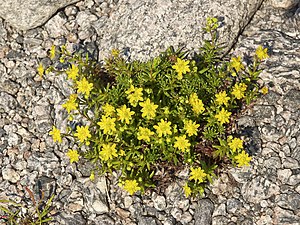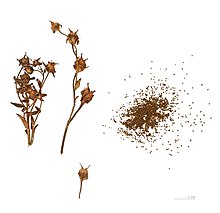Sedum saxifrage
| Sedum saxifrage | ||||||||||||
|---|---|---|---|---|---|---|---|---|---|---|---|---|

Sedum saxifrage ( Saxifraga aizoides ) in Norway |
||||||||||||
| Systematics | ||||||||||||
|
||||||||||||
| Scientific name | ||||||||||||
| Saxifraga aizoides | ||||||||||||
| L. |
The Saxifraga Aizoides ( Saxifraga aizoides ) is a plant of the genus saxifrage ( Saxifraga ). It is also known as the brook saxifrage or spring saxifrage , which indicates its preference for a moist location. More rarely, this species is also called the lashed saxifrage . The Artepipheton aizoides (Greek = always living) refers to the evergreen leaves.
description

The sedum saxifrage is a richly branched, grass-growing, perennial plant and reaches heights of about 5 to 20 centimeters. It has loosely leafed, glandular-haired stems . The mostly dark green, often red overflowing leaves are 10 to 25 mm long and are quite fleshy, whereby the species in its vegetative state resembles the genus of sedum or stonecrop . The leaf margin is ciliate, at the leaf tip a lightly placed cartilage tip can be seen.
Two to twelve flowers stand together in a loose, glandular, hairy cluster . The hermaphrodite flowers are about 15 mm in diameter. The petals are yellow to dark orange, rarely they are also dark red, with darker points. The flowering period extends from June to September.
The sedum saxifrage has chromosome number 2n = 26.
ecology
The flowers of sedum-Streinbrechs be next Diptera also ants visited. The seeds remain buoyant for three weeks and thus explain the frequent descending of rivers to far below the actual distribution area.
Occurrence
The distribution area includes the arctic and sub-arctic Canada with southern extensions on the west and east coast to the USA border. Greenland , eastern Iceland , Svalbard , Novaya Zemlya , the polar Urals and arctic NE Russia with the Kola Peninsula , Scandinavia and the Alps from the Pyrenees to the Balkans . Pollen was found in late glacial sediments in Denmark, the Netherlands and some German low mountain ranges. The plant is also common in northern Ireland and Great Britain (south to Yorkshire ).
The sedum saxifrage prefers spring meadows, but also rubble ( glacial moraines ) and rock (damp) at altitudes between 600 and 3100 meters. In the Allgäu Alps, it rises on the north ridge of the Biberkopf in Bavaria up to 2300 meters above sea level. It occurs on ooze-wet, base-rich, mostly chalky, more or less humus-poor, pure or stony-gravelly clay or marl soil, but also on stone soil with little fine earth. It thrives in Central Europe in societies of the Cratoneurion commutati association, but also occurs in moist Thlaspietea rotundifolii societies or in the Caricion davallianae. In the Arctic , it is also common in the relatively dry tundra . It descends with the rivers far into the foreland (about to Munich with the Isar ). In Northern Europe it also grows at sea level .
The sedum saxifrage is considered endangered in Austria in the northern foothills of the Alps.
Historical
This species was known to the botanist Valerius Cordus as early as 1563 under the name Sedula montana pulchra . Linné found this typical arctic-alpine plant in Lapland and gave it its current name in 1753.
Common names
In Lower Austria and Tyrol, the locals also call the sedum saxifrage "chamois", as do many other plants that chamois like to eat. In some areas of Tyrol, the name " wart herb" is also used because it was used to remove warts .
swell
literature
- Xaver Finkenzeller, Jürke Grau: Alpine flowers. Recognize and determine (= Steinbach's natural guide ). Mosaik, Munich 2002, ISBN 3-576-11482-3 , p. 98 .
- Wolfgang Adler, Karl Oswald, Raimund Fischer: Excursion flora of Austria . Ed .: Manfred A. Fischer. Eugen Ulmer, Stuttgart / Vienna 1994, ISBN 3-8001-3461-6 , p. 376 .
- Stefan Eggenberg, Adrian Möhl: Flora Vegetativa. Paul Haupt, Bern / Stuttgart / Vienna 2007, ISBN 978-3-258-07179-4 , p. 467.
- Elfrune Wendelberger: Alpine plants - flowers, grasses, dwarf shrubs. BLV, Munich / Vienna / Zurich 1984, ISBN 3-405-12868-4 .
Individual evidence
- ↑ Jaakko Jalas, Juha Suominen, Raino Lampinen, Arto Kurtto (eds.): Atlas Florae Europaeae. Distribution of Vascular Plants in Europe. 12. Resedaceae to Platanaceae. Akateeminen Kirjakauppa & Tiedekirja, The Committee for Mapping the Flora of Europe & Societas Biologica Fennica Vanamo, Helsinki 1999, ISBN 951-9108-12-2 , pp. 171-172.
- ↑ Erhard Dörr, Wolfgang Lippert : Flora of the Allgäu and its surroundings. Volume 1, IHW, Eching 2001, ISBN 3-930167-50-6 , p. 653.
- ^ Erich Oberdorfer : Plant-sociological excursion flora for Germany and neighboring areas . 8th edition. Verlag Eugen Ulmer, Stuttgart 2001, ISBN 3-8001-3131-5 . Page 489.
- ↑ Carl von Linné: Species Plantarum. Volume 1, Lars Salvius, Stockholm 1753, p. 403 ( digitized version ).
Web links
- Sedum saxifrage. In: FloraWeb.de.
- Sedum saxifrage . In: BiolFlor, the database of biological-ecological characteristics of the flora of Germany.
- Profile and distribution map for Bavaria . In: Botanical Information Hub of Bavaria .
- Saxifraga aizoides L. In: Info Flora , the national data and information center for Swiss flora .
- Distribution in the northern hemisphere from: Eric Hultén, Magnus Fries: Atlas of North European vascular plants. 1986, ISBN 3-87429-263-0 at Den virtuella floran. (Swedish)
- Thomas Meyer: Data sheet with identification key and photos at Flora-de: Flora von Deutschland (old name of the website: Flowers in Swabia )


